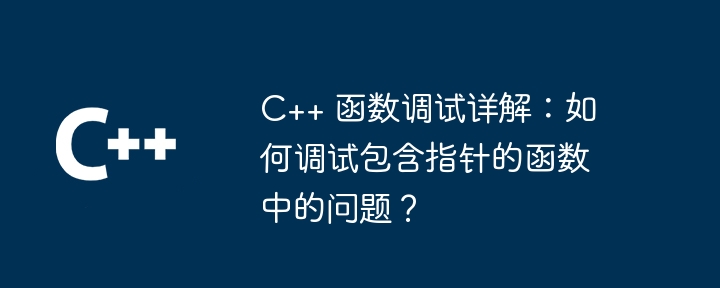
When debugging C functions that contain pointers, you need to understand pointer basics and apply debugging techniques: setting breakpoints to pause execution and inspect variables. Check that the pointer value is as expected. Verify that the pointer is null. Check the memory pointed to by the pointer. Use visual tools to inspect pointers and memory layout.

#C Detailed explanation of function debugging: How to debug problems in functions containing pointers?
Understanding pointer basics
When debugging functions that contain pointers, it is crucial to understand the basics of pointers. A pointer is a variable that stores the memory address of another variable. They allow us to manipulate raw data by reference, allowing for efficient memory management.
Debugging functions that contain pointers
To debug functions that contain pointers, we can use the following techniques:
p or print to print the pointer value. Values should be as expected. if (ptr == nullptr) or if (ptr == NULL) to check whether the pointer is null null. p/x ptr or print/x ptr command to check the memory pointed to by the pointer. Practical Case
The following code example demonstrates a function containing pointers and how to use debugging techniques to solve the problem:
#include <iostream>
using namespace std;
int* createArray(int size) {
return new int[size];
}
void modifyArray(int* arr, int size) {
for (int i = 0; i < size; i++) {
arr[i] = i * i;
}
}
int main() {
int size = 5;
int* arr = createArray(size);
modifyArray(arr, size);
for (int i = 0; i < size; i++) {
cout << arr[i] << " ";
}
cout << endl;
delete[] arr;
return 0;
}Debugging steps:
modifyArray function. p arr command to check the value of the array pointer. p arr[0] and p arr[4] commands to check the value of an array element. By using these debugging techniques, we can effectively find and solve problems in functions that contain pointers.
The above is the detailed content of Detailed explanation of C++ function debugging: How to debug problems in functions containing pointers?. For more information, please follow other related articles on the PHP Chinese website!
 What are the differences between c++ and c language
What are the differences between c++ and c language
 Recommended learning order for c++ and python
Recommended learning order for c++ and python
 Cost-effectiveness analysis of learning python and c++
Cost-effectiveness analysis of learning python and c++
 Is c language the same as c++?
Is c language the same as c++?
 Which is better to learn first, c language or c++?
Which is better to learn first, c language or c++?
 The difference and connection between c language and c++
The difference and connection between c language and c++
 C++ software Chinese change tutorial
C++ software Chinese change tutorial
 Cost-effectiveness analysis of learning python, java and c++
Cost-effectiveness analysis of learning python, java and c++




